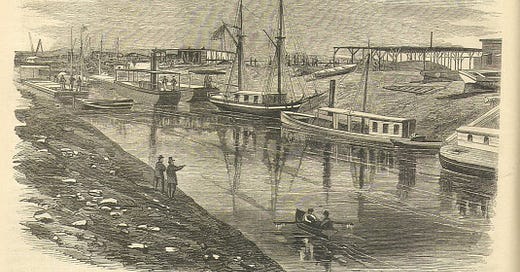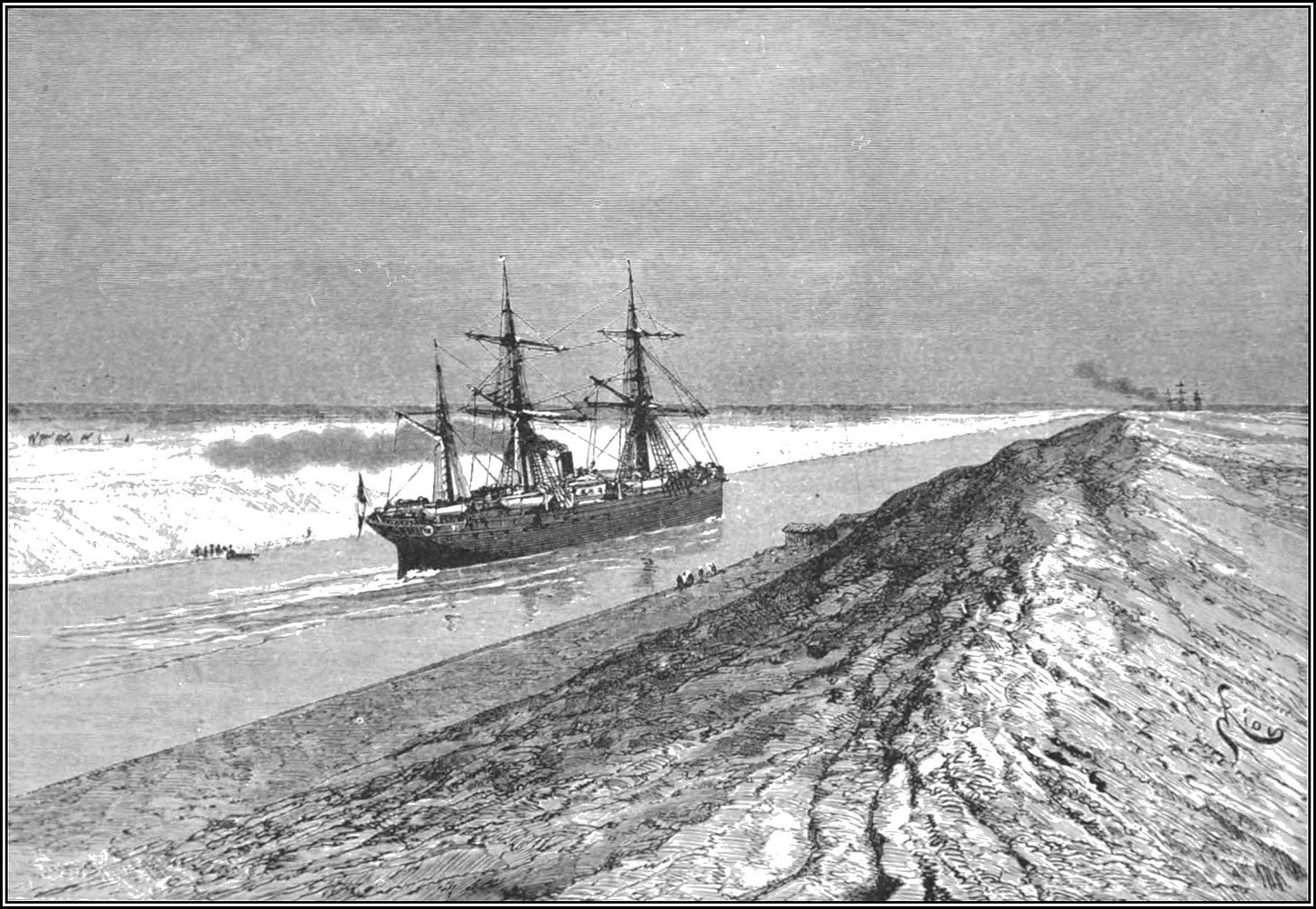Considered “one of the most important waterways in the world,” the Suez Canal sees an enormous amount of traffic. Every day, roughly 12 percent of global trade passes through its locks, at a yearly value of more than $1 trillion. When a ship got stuck in the canal and blocked traffic for just one week in 2021, it cost the world approximately $6.7 million every minute.
It was 154 years ago this November 17 that this vital artery connecting the Mediterranean and Red Seas was finished, after a decade of backbreaking work.
The Suez Canal, Appleton's Journal of Popular Literature, Science, and Art, 1869. Wikimedia.
Though the ancient Egyptians had built a canal linking a branch of the Nile River Delta and the Red Sea known as the Canal of the Pharaohs, this waterway was poorly maintained, and was eventually closed down in the 8th century by an Arab caliph seeking to deny his enemies use of this watery highway.
For a millennia people toyed with the idea of opening another canal linking East to West, including the Venetians and Napoleon Bonaparte, yet the path remained blocked. One reason was a fear that rose from the incorrect belief that the Red Sea was higher in elevation than the Mediterranean, and that any connection between the two bodies of water would lead to massive flooding, destroying the Nile valley and all who lived along it.
Despite the potential risk, many tried to find a safe solution. Opening a canal across Suez was tempting because it could offer a significant shortcut to those wishing to trade with the East. Until the canal’s completion, Westerners who wanted to participate in the lucrative trade with India and other lands in the east had to take a long journey across the south Atlantic, going along Africa’s coastline, rounding the Cape of Good Hope, and then finally making it to the Indian Ocean. Having a canal across the Isthmus of Suez would shorten that journey by thousands of miles.
The Blessing of the Suez Canal, November 16, 1869, William Simpson. Yale Center for British Art/Wikimedia.
It took another Frenchman—Napoleon III, the emperor and nephew of his more famous conquering uncle—to start things going again.
Napoleon III officially approved the idea of building the Suez Canal in October 1859 after meeting with Ferdinand de Lesseps, a French diplomat who, while having no engineering experience, “knew how to make friends with people in power, and how to raise funds.”
Lesseps had many connections, most important of which was Said Pasha, the ruler of Egypt, who gave him the go-ahead to start building the canal.
But the work wasn’t easy. Despite opposition from Western investors, Said Pasha used poor Egyptians as slave labor. They worked in horrible conditions and used primitive digging techniques. Tens of thousands died toiling under the harsh Egyptian sun.
But in 1863, Said Pasha died and was succeeded by Ismail Pasha, who stopped using slave labor. Besides the new state of affairs being infinitely more merciful to Egypt’s poor, the resulting manpower shortage meant that construction on the canal now continued with advanced tools. Roughly 75 percent of all the sand dug up during the canal’s construction “was handled by heavy machinery”.
In 1869, after ten years of hard work, the Suez Canal was officially opened and ready to accept shipping.
The Suez Canal, Africa, And Its Inhabitants, Elisée Reclus, 1892. Internet Archive Project/Wikimedia.
A French architect, Frédéric Auguste Bartholdi, wanted to commemorate the historic occasion by building a massive statue of an Egyptian woman standing guard over the canal, titled “Egypt Carrying the Light to Asia.” But when Egypt turned down the proposal, the statue ended up serving as sentinel over a much more different body of water: Bartholdi moved his project to the U.S., where, after some modifications from the original plan, the sculpture transformed into what we today know as the Statue of Liberty.
The British, who originally opposed the Suez Canal’s construction, would later realize its importance and, in 1875, bought a 44 percent share in the company that owned the canal from the Egyptian government, which would become a crucial shortcut to the most important British colony, India.
Over the next eight decades, the Suez Canal, which grew in importance as a strategic artery during times of war, would become a flashpoint in several major conflicts. In the First World War, it came under attack from the Ottomans; in the Second World War, German tanks almost severed this important Allied chokepoint; and in the 1956 Suez War, Egyptian president Gamal Abdel Nasser’s nationalization of the canal and maritime blockade of Israel provoked a war with the Jewish state, France, and Britain.
The Suez Canal has had a fascinating history, stretching from the time of the Pharaohs to Napoleon and the modern era. A highway of empire, a cause of war, and a crucial global trade route, the importance of Lesseps’s gateway between Europe and Asia reverberates to this day.







